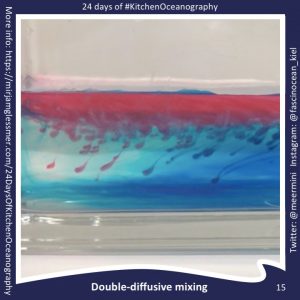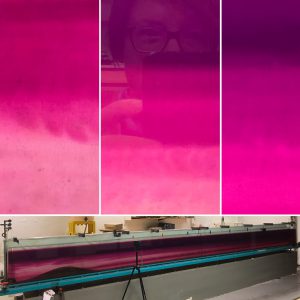
Tag: mixing



Tank demonstration of the circulation in a fjord
It has been a long time in the making, but finally we have a nice fjord circulation in our tank! Pierre and I tried to improve it 6 years ago,…

Accidental double-diffusive mixing
When setting up the stratification for the Nansen “dead water” demo (that we’ll show later today, and until then I am not allowed to share any videos, sorry!), I went…

Layered latte: A great real-life example of double-diffusive mixing!
Sometimes sitting in a café for a work meeting with #lieblingskollegin Julia can lead to unexpected discoveries of oceanographic processes — in my latte! It’s those little things that inspire blog…

Tides themselves don’t induce (a lot of) mixing, only tides hitting topography do. An experiment.
As you might have noticed, the last couple of days I have been super excited to play with the large tanks at GFI in Bergen. But then there are also…

Experiment: Influence of stratification on mixing
A wind stress is applied to the surface of a stratified and a non-stratified tank to cause mixing. This is a pretty impressive experiment to run if you have a…

“Laboratory layered latte” – combining latte and double diffusion. Easily my favourite paper ever!
My friends know me well. Especially A&I, which was proven again when they sent me the link to an article about two things that I am mildly obsessed with: Latte…

Café Latte
Even though most people think I am crazy, I always love watching the convection pattern develop in a hot drink.

My favorite demonstration of the coolest mixing process: Salt fingering!
I am updating many of my old posts on experiments and combining multiple posts on the same topic to come up with a state-of-the-art post, so you can always find the…

Influence of stratification on mixing
A wind stress is applied to the surface of a stratified and a non-stratified tank to cause mixing. This is an experiment that Martin and I ran at the JuniorAkademie this…

Mixing in a non-stratified and in a stratified tank
A wind stress is applied to the surface to cause mixing. This is an experiment that I have been wanting to do for a long time, but somehow it never…

Marsigli’s experiment
Density-driven flow. The experiment presented in this post was first proposed by Marsigli in 1681. It illustrates how, despite the absence of a difference in the surface height of two fluids,…

Salt fingering – DIY
How to easily set up the stratification for the salt fingering process. Setting up stratifications in tanks is a pain. Of course there are sophisticated methods, but when you want…

Diffusive layering. Or: This is not a trick question!
The “other” double-diffusive mixing process. After having talked extensively about double diffusive mixing in my courses, I tend to assume that students not only remember that there is such thing as…

Salt fingering
How to show my favorite oceanographic process in class, and why. As I mentioned in this post, I have used double-diffusive mixing extensively in my teaching. For several reasons: Firstly,…

Double-diffusive mixing
On the coolest process in oceanography. My favorite oceanographic process, as all of my students and many of my acquaintances know, is double-diffusive mixing. Look at how awesome it is:…